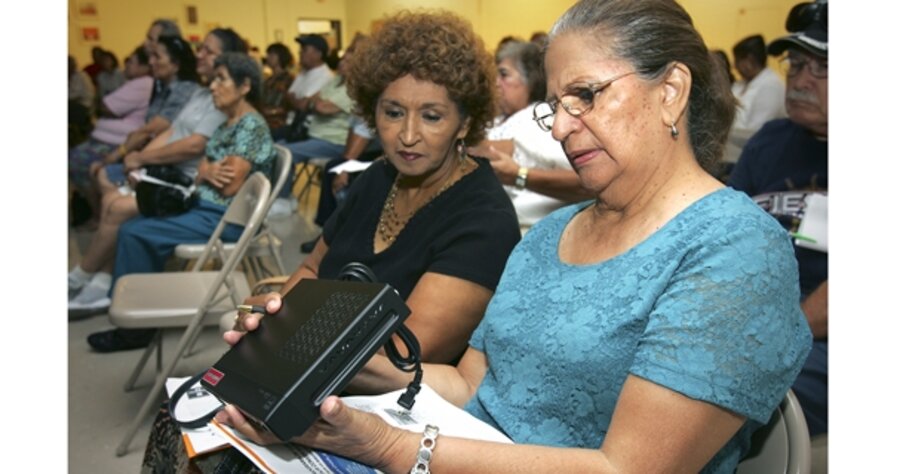Thanks to DTV, my television has ‘fallen off a cliff’
Loading...
As I’ve mentioned several times in the past, I live in a part of rural Virginia undiscovered by cable TV companies. I won’t use a satellite dish for a number of reasons – for one, they look like barnacles on the side of a house. So I’ve depended on broadcast TV signals for the past year.
I don’t watch much television, so it has not been so bad. The picture is a little fuzzy, but not so covered in static that I can’t enjoy a movie or political debate.
But analog TV signals are going away on Feb, 17. On that day, federal law demands that all over-the-air signals switch to digital (DTV). Currently, many stations broadcast in both digital and analog formats, giving people several months to prepare.
If you have cable or satellite TV, this is not a problem for you. That’s most people in the United States – about 60 million homes, according to a recent report. But in some areas, as many as one in five homes only receive broadcast signals. For example, the El Paso Times last month quoted a Nielsen Media Research report that found 22 percent of homes in that area of Texas are not ready for the DTV switch.
But the solution is easy, according to the Federal Communications Commission (FCC). You can either buy a new digital TV (in this economy?) or a set-top converter box that will transform digital signals into something that your old analog TV will recognize. The government offers families two $40 coupons to help purchase these converters.
I had paid no attention to this until my neighbor got a set-top converter. Suddenly, his fuzzy signals were transformed into something amazing: clear, crisp pictures like you get when you have cable. He even got 20 channels, including new ones he had never seen before.
So I thought, “why not.” I went to the FCC website that is giving out the coupons (dtv2009.gov) and ordered two. When they arrived a few weeks later, I scurried down to the local RadioShack and picked up a converter. I hooked it up to my old, in-house antenna and sat back to see what I could get on my “improved” TV.
That’s when the problems started.
I could only pick up about five channels, eight at most. And they were never the same ones. Twist the antenna one way and get ABC and NBC. Turn it another way and get CBS and Fox. I couldn’t get any PBS stations at all, which were the real reason I wanted to get a better signal in the first place.
I bought a longer coaxial cable so that I could move the antenna. I put it on top of a bookcase. I piled up a few boxes in one corner and put it there. Et cetera. Et cetera. Nothing improved the signal.
Then I bought a signal booster. No change. I bought a new digital antenna. The picture actually grew worse, so I took it back. The signal was super finicky. If I walked in a certain part of the room, the signal disappeared all together.
How could my neighbor get so much reception, and I get so little? I decided to do a little research.
The first thing you need to know about a digital TV signal is that you either get it, or you don’t. Unlike analog TV, which still produces a fuzzy picture if reception is poor, digital gives you all or nothing. The moment the signal drops below a certain level, the set goes black. The TV industry has an interesting way to describe this: “falling off a cliff.” No kidding.
Discovery two: A digital signal is affected by practically everything – where your TV set is located in your house, the walls in your house, the number of trees in your yard, how close it is to other electronic devices, birds migrating south in the fall. No kidding. A Washington Post story described how a woman who lived on the 20th floor of an apartment building would lose her signal for a few moments every time a plane landed or took off from Reagan National airport.
My third finding: Indoor antennas are almost useless when it comes to digital signals. Oh, if you live in the right place, have no criminal record, and go to church every Sunday, you might get the entire broadcast spectrum. But chances are you’ll end up like me.
You can buy an outdoor antenna and hope for the best. Of course, if you live in an apartment building or condo, putting up an outdoor antenna is a bit more difficult. The FCC has ruled that no one can prevent you from putting up an antenna (despite what the apartment or association rules might say). But getting a clear picture might not be worth dealing with nagging neighbors or a treacherous climb onto the roof.
Either way, take this as a warning: Don’t wait until February to update your TV. At least I can still get analog TV for a few more months while I sort this out.
What bothers me the most about this entire exercise? I feel led astray. The information that has been coming out from broadcasters and the FCC about the switch from analog to digital has been nothing but glowing. They haven’t told us (or at least haven’t spoken loudly enough) about the problems we might have getting digital signals. They haven’t told people about the extra expense that might be involved. And they haven’t told people that come Feb. 17, their television-viewing experience might be worse, not better.
The FCC has done several test rollouts in small cities such as Wilmington, N.C., and says it’s already refining its DTV strategy to make the transition as easy as possible. But for some of us, I think we’re going to be stranded here for a while.





